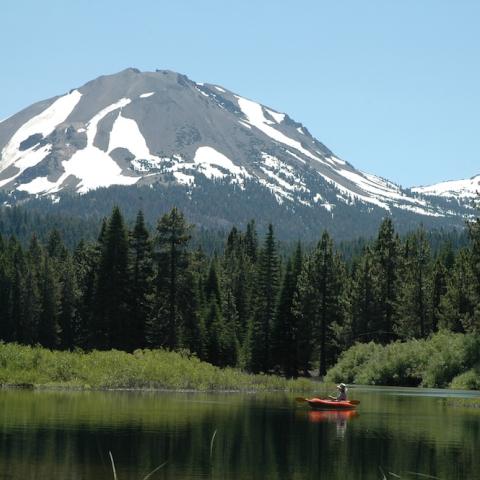
A view from Cinder Cone summit of the surrounding volcanic landscape, Lassen Volcanic National Park / Rebecca Latson
Sometimes, it takes a monumental event to spur Congress into establishing a national park. Such a significant event, or rather, series of events, occurred between 1914 and 1915 when Lassen Peak in northern California began belching billowing black mushroom clouds of steam, ash, and hot rocks onto the landscape as far as 200 miles (322 kilometers) from the summit during several eruptions.
According to park staff:
… the park was established as a unit of the national park system in 1916 shortly after a series of highly publicized, dramatic volcanic eruptions of Lassen Peak in 1914 and 1915. Prior to the park’s establishment, Cinder Cone National Monument and Lassen Peak National Monument were established in this area by proclamation of President Theodore Roosevelt in 1907 to be administered by the U.S. Forest Service. These two monuments and surrounding areas were combined into what later became Lassen Volcanic National Park.
A visit to Lassen introduces you to volcanic features resulting from those 20th-century explosive episodes as well as from eruptions occurring thousands of years ago. You’ll drive past 1,100-year-old lava domes from which sloughed rocky debris extending almost 10 miles into the valley floors. You’ll notice truck-sized boulders dotting the roadside, tossed from Lassen Peak’s exploding crater like so many baseballs at a batting cage.
Hike up to the summit of either Cinder Cone in the far northeast corner of the park, or Lassen Peak to the central west for grand views of the park’s volcanic landscape, including the colorful Painted Dunes and blocky Fantastic Lava Beds.
Wander the boardwalk at Bumpass Hell past boiling mudpots, hissing fumaroles, and steaming acidic lakes, or walk alongside the main park road to view (and smell) Sulphur Works’ mud pots and fumaroles. These hydrothermal areas represent ground-level evidence of what scientists believe is a cooling-but-not-yet-extinguished underlying magma chamber.
Feel like a hike? There are more than 150 miles of day-hiking and backcountry trails from easy to strenuous difficulty levels guiding you through open meadows, over hydrothermal areas, up volcanic mountains, and into forests toward quiet lakes. You can even hike a portion of the historic Nobles Emigrant Trail used by pioneers looking for a shorter route west to the promised land of the California coast. Some of these trails require caution as they wind through the aftermath of the 2021 Dixie Fire. While they are no longer closed, areas are still recovering from a conflagration which burned 73,240 acres (29,639 hectares) within the park.
Lassen is home to 300 species of vertebrates, so it’s entirely possible you might spot a Douglas’s squirrel in the trees or an American pika scurrying around the rocky hillside during your hiking adventures. If you don’t see the pika, you’ll probably hear its hi-pitched squeal. This park is bear country, with an estimated population of 50 black bears, mostly seen in the southwestern portion.
Do you enjoy birding or bird photography? If so, pack along your binoculars and camera to look for any of the 200 bird species known to either live within or migrate through Lassen’s landscape, including woodpeckers, hummingbirds, owls, hawks, and grouse.
If you feel like spending a night or two in the park, there are two lodging options: the Manzanita Camping Cabins next to Manzanita Lake, and Drakesbad Guest Ranch in the Warner Valley. Situated on one side of Manzanita Lake, and next door to the Manzanita Lake Campground in the northwest portion of the park, the camping cabins offer a rustic bare-bones camping experience, while Drakesbad Guest Ranch - the only hotel-type lodging within the park – offers rustic accommodations, meals, and activities such as horseback riding, fishing, and access to nearby hiking trails. Closed since the 2021 Dixie Fire, the guest ranch is preparing to open for the 2025 season.
If you’d rather pitch a tent and sleep directly beneath the starry sky, there are seven campgrounds from which to choose, although three currently remain closed for Dixie Fire recovery.
Lassen Volcanic National Park is open year-round, although services and hours are limited during the winter and the main park road is closed between the Kohm Yah-mah-nee Visitor Center (southwest entrance) and Loomis Plaza/Manzanita Lake parking area (northwest entrance) during that time. Don’t let that stop you from visiting when the snow falls, however. If you enjoy winter activities such as snowshoeing, cross-country skiing, and sledding in solitude and without the crowds, this is the park to visit.
Traveler’s Choice For: Volcanoes, geology, hiking, photography




 Support Essential Coverage of Essential Places
Support Essential Coverage of Essential Places






